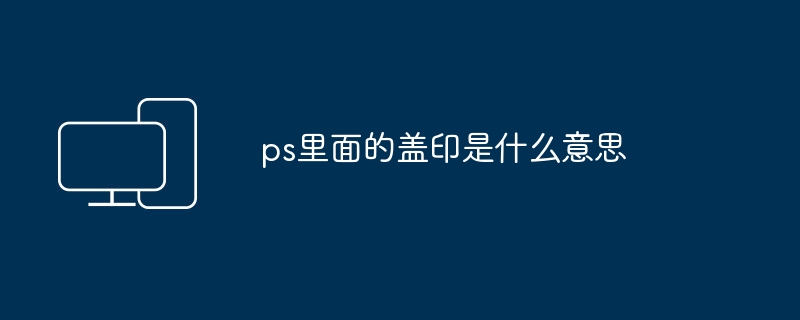Home >Computer Tutorials >Computer Knowledge >What is printing and stamping in PS?
What is printing and stamping in PS?
- 王林forward
- 2024-01-24 15:48:051012browse

What does the stamp in ps mean
Stamp layer
Stamping is a method of processing images. It stamps the processed effects onto a new layer. It is similar to the function of merging layers, but is more convenient and practical. The difference is that stamping will generate a brand new layer and will not have any impact on the previously processed layers. The advantage of this is that if the previous processing effect is not satisfactory, you can delete the stamp layer and the layer where the effect was previously performed will still remain. This method greatly facilitates the image processing process and saves time.
The shortcut key is ctrl alt e
Steps:
Be sure to create a new transparent layer before editing a layer. This step is easy, just click the New button below the Layers panel.
By pressing the shortcut key Ctrl Alt Shift E, we can copy the effect of the current layer to the new layer, so that we can see the just completed effect on the new layer.
Apply the combined effect of all layers to the current layer, but retain the layers below for future editing.
What does it mean to stamp visible layers in PHOTOSHOP? What does it do
PS Tips: Stamp visible layers
Many people have seen "stamp visible layer" or "stamp" but don't understand its meaning. Let me answer it! Stamp Visible Layers merges all underlying layers into a new layer, but still preserves all underlying layers for later modifications.
method:
(1)ctrl alt shift e is to stamp all layer data
(2) You can link several layers and then ctrl alt e to stamp the linked layers.
(3) Create a new layer 1 on the text layer, hold down ALT and use the small triangle on the right side of the panel to find "Flat Visible Layers". Note: Neither ALT nor the mouse can be placed, and you will see the new layer. It contains two layers of content, recording the contents of all visible layers like a historical snapshot, and merging them into one layer for easy editing. (In the history panel, call: Stamp visible layer)
Function: Merge visible layers into new layers while retaining (not destroying) the original layers.
The official explanation is:
After you have determined the contents of your layers, you can merge the layers to create a partial version of the composite image. This helps manage image file size. When you merge layers, the data on the higher layer replaces the data on the lower layer it covers. In the merged layer, any overlapping transparent areas will remain transparent.
Several related shortcut keys:
Merge downward or merge joined layers [Ctrl] [E]
Merge visible layers [Ctrl] [Shift] [E]
Stamp or stamp the connection layer [Ctrl] [Alt] [E]
Stamp visible layer [Ctrl] [Alt] [Shift] [E]
What is the function of PS stamp layer
The function is as follows: Stamping the layer is to turn the combined effect of all layers into one layer, but retain all the previous layers and there is no real combined layer, so that you can continue to edit individual layers in the future.
Stamping layer is to stamp the processed effect on a new layer when processing the image. The function is similar to that of merging layers, but it is more useful than merging layers because stamping is to regenerate a new layer. The new layer will not affect the previously processed layer at all. The advantage of this is that if you feel that the effect of the previous processing is not satisfactory, you can delete the stamp layer, and the layer that created the effect before will still be there. It can also save time by processing images to a great extent.
Steps:
1. Create a new layer: Before stamping, you must first create a new transparent layer, or add an adjustment layer and a neutral color layer.
2. Press the shortcut key Ctrl Alt Shift E to stamp all visible layers; Ctrl Alt E to stamp the selected layer.
The above is the detailed content of What is printing and stamping in PS?. For more information, please follow other related articles on the PHP Chinese website!

